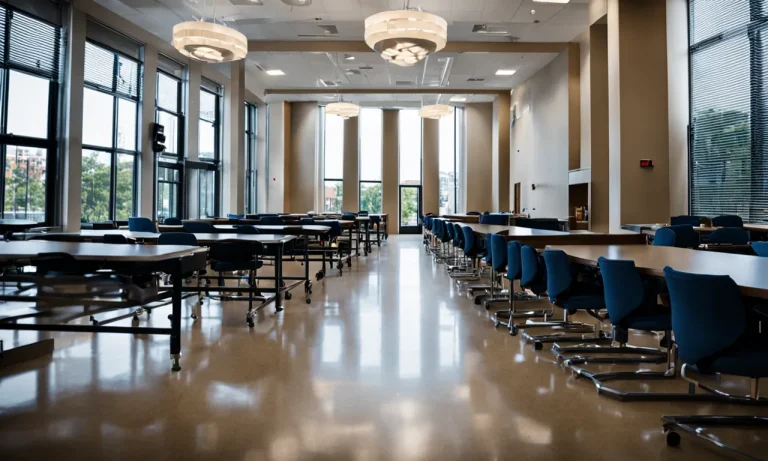If you’ve ever eaten a school lunch, you probably know exactly what we mean when we say they’re bad. From mystery meats and mushy vegetables to prepackaged snacks loaded with preservatives, school cafeteria food often leaves much to be desired.
But why exactly are school lunches so notoriously unappetizing and unhealthy? If you’re looking for answers, you’ve come to the right place.
If you’re short on time, here’s a quick answer to your question: School lunches are bad because of low budgets, lack of equipment and staff in cafeterias, nutritional guidelines that restrict flavors, and contracts with big food suppliers.
Most schools simply don’t have the resources or flexibility to provide fresh, homemade meals.
In this comprehensive article, we’ll explore all the factors that contribute to the decline of cafeteria food quality. We’ll look at school lunch budget history, equipment challenges, federal nutrition standards, food supplier monopolies, and more.
You’ll learn why pizza and chicken nuggets dominate lunch menus across America. We’ll also provide some solutions and tips for schools, parents, and communities to help bring better food back onto the lunch tray.
The Impact of Limited Budgets
When it comes to school lunches, one of the main reasons why they often fall short in terms of quality and nutrition is the impact of limited budgets. Schools are faced with the challenge of providing meals to a large number of students while working with limited financial resources.
This can have a significant impact on the overall quality of the food that is served.
View this post on Instagram
Early National School Lunch Program Funding
The National School Lunch Program (NSLP) was established in 1946 with the goal of providing nutritious meals to school children. However, the initial funding for the program was limited, which meant that schools had to find ways to provide meals within a tight budget.
This often resulted in the use of low-cost ingredients and processed foods that may not meet the nutritional needs of growing children.
The average reimbursement rate for schools participating in the NSLP is $3.85 per meal. This amount must cover the cost of food, labor, and other expenses associated with meal preparation.
With such limited funds, it can be challenging for schools to provide meals that are both nutritious and appealing to students.
Declining Federal Reimbursements
In recent years, federal reimbursements for school lunches have declined, putting even more strain on school budgets. This has made it increasingly difficult for schools to provide meals that meet the nutritional guidelines set by the USDA.
As a result, some schools have had to cut back on the quality and variety of food options available to students.
The decline in federal reimbursements has also led to a reduction in the amount of fresh fruits and vegetables served in school lunches.
Reliance on USDA Commodities
To help offset the costs of providing school lunches, many schools rely on USDA commodities, which are government-provided foods. While these commodities can help schools stretch their budgets, they often consist of processed and pre-packaged foods that may not be the healthiest options for students.
Lack of Funding for Kitchen Upgrades and Staff
In addition to limited funds for food, many schools also struggle with a lack of funding for kitchen upgrades and staff. Outdated kitchen equipment and facilities can make it difficult to prepare fresh, from-scratch meals.
Insufficient staffing levels can also impact the ability to provide healthy and diverse meal options.
According to a one report, 55% of school districts surveyed reported needing at least one major kitchen equipment upgrade and 88% of school districts need at least one additional piece of kitchen equipment. However, limited funding often prevents schools from making these necessary upgrades, further hindering their ability to provide better quality school lunches.
Challenges of Facilities and Equipment
One of the main reasons why school lunches can be so bad is the challenges schools face when it comes to their facilities and equipment. These challenges can greatly impact the quality and variety of meals that are served to students on a daily basis.
Small, Outdated Kitchens
Many schools have small, outdated kitchens that are ill-equipped to handle the demands of preparing nutritious meals for a large number of students. These cramped spaces often lack the necessary storage and work areas, making it difficult for cafeteria staff to efficiently prepare meals.
This can result in limited menu options and a reliance on pre-packaged or processed foods.
According to a report from The Pew Charitable Trusts and the Robert Wood Johnson Foundation, only 42% of school food authorities reported having a budget to purchase capital equipment.
This limitation hinders the ability to provide fresh and healthy options for students.
Lack of Cooking Equipment
Another challenge schools face is the lack of cooking equipment necessary to prepare meals from scratch. Many kitchens are equipped with only basic appliances, such as ovens and stovetops, which limit the types of meals that can be made.
This can result in a heavy reliance on processed foods that are quick and easy to prepare.
The lack of equipment limits the culinary creativity of cafeteria staff and restricts their ability to provide nutritious meals to students.
Minimal Training for Cafeteria Staff
In addition to the challenges of facilities and equipment, many cafeteria staff members receive minimal training in cooking and nutrition. This can lead to a lack of knowledge and skills when it comes to preparing healthy and balanced meals for students.
Without proper training, cafeteria staff may resort to using pre-packaged or processed foods as a default option.
Cafeteria staff should receive ongoing professional development and training to enhance their culinary skills and stay up to date with nutrition guidelines. However, budget constraints and time limitations often prevent schools from providing this level of training, resulting in a less than optimal dining experience for students.
Nutrition Standards Restrict Creativity
When it comes to school lunches, one of the main reasons why they are often considered “bad” is because of the strict nutrition standards that schools must adhere to. These standards, while well-intentioned, can limit the creativity and variety of meals that schools can offer to students.
View this post on Instagram
History of National School Lunch Regulations
The history of national school lunch regulations dates back to the 1940s when the National School Lunch Program (NSLP) was established. The primary goal of the program was to provide nutritious meals to children from low-income families.
Over the years, the program has evolved, with the implementation of various nutrition standards and guidelines.
However, as these regulations have become more stringent, schools have found it increasingly challenging to meet the requirements while still offering meals that students find appealing. This has led to a lack of creativity in school lunch menus, resulting in the perception that the meals are “bad.”
Limitations of Modern Nutrition Standards
Modern nutrition standards focus on limiting the amount of calories, fat, and sodium in school lunches. While these restrictions are meant to promote healthier eating habits and combat childhood obesity, they can also be seen as overly restrictive and limiting.
For example, schools are often required to offer a certain amount of fruits and vegetables, whole grains, and lean proteins. While these are undoubtedly healthy choices, it leaves little room for other options that students may enjoy.
The lack of variety in school lunches can lead to dissatisfaction among students, resulting in less consumption of the provided meals.
Focus on Limiting Calories, Fat, and Sodium
The primary focus of nutrition standards for school lunches is to limit the intake of calories, fat, and sodium. While these are important factors to consider for a healthy diet, they should not be the sole focus when designing school lunch menus.
Evidence suggests that a well-balanced diet includes a variety of nutrients, including carbohydrates, proteins, and fats. By solely focusing on limiting calories, fat, and sodium, schools may unintentionally overlook the importance of providing students with a balanced and nutritious meal.
It is crucial to strike a balance between meeting nutrition standards and offering meals that students enjoy. This can be achieved by incorporating more diverse options, such as ethnic cuisines, vegetarian or vegan alternatives, and foods that reflect the cultural backgrounds of the students.
Reliance on Large Food Suppliers
One of the main reasons why school lunches are often criticized for being of poor quality is the reliance on large food suppliers. A handful of corporations dominate the market and supply the majority of school meals across the country.
This lack of diversity in suppliers can lead to a lack of variety in the food options available to students.
A Handful of Corporations Supply Most School Meals
It may come as a surprise to many, but only a few corporations supply the majority of school meals. This means that a significant portion of the food served in schools comes from the same sources, resulting in limited options and repetitive menus.
This lack of competition can lead to a lack of innovation and quality control in the meals provided to students.
Pre-Packaged and Processed Items
Another consequence of relying on large food suppliers is the prevalence of pre-packaged and processed items in school lunches. These suppliers often prioritize convenience and cost-efficiency over nutritional value and taste.
As a result, students are often served meals that are high in sodium, saturated fats, and added sugars, which can have negative impacts on their health and well-being.
The overconsumption of sodium can contribute to high blood pressure and other health issues in children and adolescents.
Contract Limitations
Contract limitations can also contribute to the poor quality of school lunches. Many school districts have contracts with large food suppliers that dictate what can and cannot be served in schools. These contracts often prioritize cost over quality, making it difficult for schools to source fresh and nutritious ingredients.
As a result, schools are often limited to pre-packaged and processed items that can be stored for long periods of time without spoiling. This further exacerbates the issue of unhealthy and unappealing school lunches.
In order to address these issues, some schools and districts are exploring alternative options such as farm-to-school programs, which promote the use of locally sourced ingredients and provide students with healthier and more sustainable food choices.
These programs not only support local farmers but also ensure fresher and more nutritious meals for students.
View this post on Instagram
Strategies for Improvement
Increasing Funding at State and Local Levels
One of the key strategies to improve school lunches is by increasing funding at state and local levels. Adequate funding can ensure that schools have the resources to provide nutritious and delicious meals for students.
By allocating more funds towards school lunch programs, schools can afford to purchase high-quality ingredients, hire skilled kitchen staff, and invest in better equipment and facilities.
According to a report by the U.S. Department of Agriculture, schools with higher funding for their lunch programs tend to offer healthier meals and have higher student participation. By investing in school lunches, we are investing in the health and well-being of our students.
Kitchen Upgrades and Staff Training
Another important aspect of improving school lunches is upgrading kitchen facilities and providing staff training. Outdated kitchen equipment can limit the variety and quality of meals that can be prepared.
By upgrading to modern appliances and tools, schools can enhance their cooking capabilities and offer a wider range of nutritious options.
Additionally, providing ongoing training for kitchen staff is crucial. Training programs can educate staff on proper food handling and preparation techniques, menu planning, and nutrition guidelines. Well-trained staff can ensure that meals are prepared safely and meet the nutritional needs of students.
View this post on Instagram
Engaging Students and Community
Engaging students and the wider community is essential in the improvement of school lunches. Students should have a voice in what is served in their cafeterias, as they are the ones consuming the meals.
Schools can involve students in the menu planning process, allowing them to provide input and suggestions for healthier and more appealing options.
Furthermore, schools can collaborate with local farmers, chefs, and nutritionists to educate students about the importance of healthy eating and to bring fresh, local produce into the school lunch program.
Community partnerships can also provide opportunities for schools to access additional resources, funding, and expertise to improve their lunch offerings.
Farm to School Programs
Farm to School programs are gaining popularity as a way to improve the quality of school lunches. These programs aim to connect schools with local farmers and suppliers, ensuring that fresh and seasonal produce is incorporated into school meals.
By sourcing ingredients locally, schools can support the local economy, reduce transportation costs, and provide students with healthier and more flavorful options.
Farm to School programs have been shown to increase students’ consumption of fruits and vegetables, improve their knowledge of food and agriculture, and support local farmers.
These programs not only enhance the nutritional value of school lunches but also contribute to a more sustainable and resilient food system.
Policy Changes
In order to bring about lasting improvements to school lunches, policy changes are necessary at both the federal and local levels. Policies can establish nutritional standards for school meals, limit the availability of unhealthy options, and incentivize the use of fresh and locally-sourced ingredients.
Advocacy groups like the Healthy School Food Coalition work towards influencing policies related to school lunches, aiming to create a healthier food environment for students. By advocating for policy changes, we can ensure that all schools have the necessary guidelines and resources to provide nutritious and appealing meals to their students.
By implementing these strategies, we can work towards improving school lunches and promoting the health and well-being of our students. Adequate funding, kitchen upgrades, student engagement, Farm to School programs, and policy changes are all vital components in the journey towards better school meals.
Conclusion
While school lunches may never be as delicious as meals prepared at home, there are still many actions that can be taken to improve their quality. With more funding, better facilities, increased flexibility in nutrition guidelines, and engagement from the community, we can work to bring fresher, healthier, and tastier foods into cafeterias.
It will require effort and advocacy, but students across the country deserve better than reheated chicken nuggets and cardboard pizza.
In providing comprehensive detail on all the factors impacting today’s school lunches, we hope this article has shed light on an important issue. While budgets and policies present very real obstacles, there is still hope for the future of school food.
It will take creativity and persistence from all stakeholders, but positive change is possible when we work together to give students the nutritious, appetizing meals they need to succeed.






